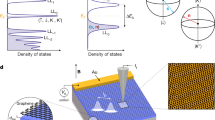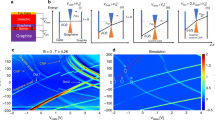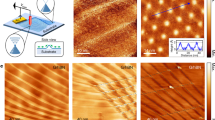Abstract
Interacting electrons in flat bands give rise to a variety of quantum phases. One fundamental aspect of such states is the ordering of the various flavours—such as spin or valley—that the electrons can possess and the excitation spectrum of the broken-symmetry states that they form. These properties cannot be probed directly with electrical transport measurements. The zeroth Landau level of monolayer graphene with fourfold spin–valley degeneracy is a model system for such investigations, but the nature of its broken-symmetry states—particularly at partial fillings—is still not understood. Here we demonstrate a non-invasive spectroscopic technique with a scanning tunnelling microscope and use it to perform measurements of the valley polarization of the electronic wavefunctions and their excitation spectrum in the partially filled zeroth Landau level of graphene. We can extract information such as the strength of the Haldane pseudopotentials that characterize the repulsive interactions underlying the fractional quantum states. Our experiments also demonstrate that fractional quantum Hall phases are built upon broken-symmetry states that persist at partial filling. Our experimental approach quantifies the valley phase diagram of the partially filled Landau level as a model flat-band platform, which is applicable to other graphene-based electronic systems.
This is a preview of subscription content, access via your institution
Access options
Access Nature and 54 other Nature Portfolio journals
Get Nature+, our best-value online-access subscription
$29.99 / 30 days
cancel any time
Subscribe to this journal
Receive 12 print issues and online access
$209.00 per year
only $17.42 per issue
Buy this article
- Purchase on Springer Link
- Instant access to full article PDF
Prices may be subject to local taxes which are calculated during checkout




Similar content being viewed by others
Data availability
The data that support the findings of this study are available at Figshare (https://doi.org/10.6084/m9.figshare.22807172).
Code availability
The code that supports the findings of this study is available at Figshare (https://doi.org/10.6084/m9.figshare.22807172).
References
Ezawa, Z. F. Quantum Hall Effects: Field Theoretical Approach and Related Topics (World Scientific, 2008).
Halperin, B. I. Fractional Quantum Hall Effects: New Developments (World Scientific, 2020).
Nomura, K. & MacDonald, A. H. Quantum Hall ferromagnetism in graphene. Phys. Rev. Lett. 96, 256602 (2006).
Young, A. F. et al. Spin and valley quantum Hall ferromagnetism in graphene. Nat. Phys. 8, 550–556 (2012).
Giamarchi, T. Disordered Wigner crystals. Preprint at https://doi.org/10.48550/arxiv.cond-mat/0205099 (2002).
Du, R. R. et al. Strongly anisotropic transport in higher two-dimensional Landau levels. Solid State Commun. 109, 389–394 (1999).
Ro, D. et al. Electron bubbles and the structure of the orbital wave function. Phys. Rev. B 99, 201111 (2019).
Eisenstein, J. P., Cooper, K. B., Pfeiffer, L. N. & West, K. W. Insulating and fractional quantum Hall states in the first excited Landau level. Phys. Rev. Lett. 88, 076801 (2002).
Xia, J. S. et al. Electron correlation in the second Landau level: a competition between many nearly degenerate quantum phases. Phys. Rev. Lett. 93, 176809 (2004).
Dean, C. R. et al. Multicomponent fractional quantum Hall effect in graphene. Nat. Phys. 7, 693–696 (2011).
Sarma, S. D. & Pinczuk, A. Perspectives in Quantum Hall Effects (Wiley, 2023).
Haldane, F. D. M. Fractional quantization of the Hall effect: a hierarchy of incompressible quantum fluid states. Phys. Rev. Lett. 51, 605–608 (1983).
Dial, O. E., Ashoori, R. C., Pfeiffer, L. N. & West, K. W. Anomalous structure in the single particle spectrum of the fractional quantum Hall effect. Nature 464, 566–570 (2010).
MacDonald, A. H. Theory of high-energy features in the tunneling spectra of quantum-Hall systems. Phys. Rev. Lett. 105, 206801 (2010).
Liu, X. et al. Visualizing broken symmetry and topological defects in a quantum Hall ferromagnet. Science 375, 321–326 (2022).
Coissard, A. et al. Imaging tunable quantum Hall broken-symmetry orders in graphene. Nature 605, 51–56 (2022).
Li, S.-Y., Zhang, Y., Yin, L.-J. & He, L. Scanning tunneling microscope study of quantum Hall isospin ferromagnetic states in the zero Landau level in a graphene monolayer. Phys. Rev. B 100, 085437 (2019).
Yoo, H. M., Baldwin, K. W., West, K., Pfeiffer, L. & Ashoori, R. C. Spin phase diagram of the interacting quantum Hall liquid. Nat. Phys. 16, 1022–1027 (2020).
Pierce, A. T. et al. Thermodynamics of free and bound magnons in graphene. Nat. Phys. 18, 37–41 (2022).
Zhou, H. et al. Strong-magnetic-field magnon transport in monolayer graphene. Phys. Rev. X 12, 021060 (2022).
Miller, D. L. et al. Observing the quantization of zero mass carriers in graphene. Science 324, 924–927 (2009).
Li, G., Luican, A. & Andrei, E. Y. Scanning tunneling spectroscopy of graphene on graphite. Phys. Rev. Lett. 102, 176804 (2009).
Walkup, D. et al. Tuning single-electron charging and interactions between compressible Landau level islands in graphene. Phys. Rev. B 101, 035428 (2020).
Song, Y. J. et al. High-resolution tunnelling spectroscopy of a graphene quartet. Nature 467, 185–189 (2010).
Miller, D. L. et al. Real-space mapping of magnetically quantized graphene states. Nat. Phys. 6, 811–817 (2010).
Jung, S. et al. Evolution of microscopic localization in graphene in a magnetic field from scattering resonances to quantum dots. Nat. Phys. 7, 245–251 (2011).
Luican, A., Li, G. & Andrei, E. Y. Quantized Landau level spectrum and its density dependence in graphene. Phys. Rev. B 83, 041405 (2011).
Chae, J. et al. Renormalization of the graphene dispersion velocity determined from scanning tunneling spectroscopy. Phys. Rev. Lett. 109, 116802 (2012).
Gutiérrez, C. et al. Interaction-driven quantum Hall wedding cake-like structures in graphene quantum dots. Science 361, 789–794 (2018).
Ghahari, F. et al. An on/off Berry phase switch in circular graphene resonators. Science 356, 845–849 (2017).
Luican-Mayer, A. et al. Screening charged impurities and lifting the orbital degeneracy in graphene by populating Landau levels. Phys. Rev. Lett. 112, 036804 (2014).
Götz, K. J. G., Schupp, F. J. & Hüttel, A. K. Carbon nanotube millikelvin transport and nanomechanics. Phys. Status Solidi B 256, 1800517 (2019).
Lim, L.-K., Goerbig, M. O. & Bena, C. Theoretical analysis of the density of states of graphene at high magnetic fields using Haldane pseudopotentials. Phys. Rev. B 84, 115404 (2011).
Chen, J. Introduction to Scanning Tunneling Microscopy (Oxford University Press, 2007).
Yang, F. et al. Experimental determination of the energy per particle in partially filled Landau levels. Phys. Rev. Lett. 126, 156802 (2021).
Polshyn, H. et al. Quantitative transport measurements of fractional quantum Hall energy gaps in edgeless graphene devices. Phys. Rev. Lett. 121, 226801 (2018).
Hegde, S. S. & Villadiego, I. S. Theory of competing charge density wave, Kekulé, and antiferromagnetically ordered fractional quantum Hall states in graphene aligned with boron nitride. Phys. Rev. B 105, 195417 (2022).
Sodemann, I. & MacDonald, A. H. Broken SU(4) symmetry and the fractional quantum Hall effect in graphene. Phys. Rev. Lett. 112, 126804 (2014).
Velasco, J. Jr et al. Competing ordered states with filling factor two in bilayer graphene. Nat. Commun. 5, 4550 (2014).
Kwan, Y. H. et al. Kekulé spiral order at all nonzero integer fillings in twisted bilayer graphene. Phys. Rev. X 11, 041063 (2021).
Hong, J. P., Soejima, T. & Zaletel, M. P. Detecting symmetry breaking in magic angle graphene using scanning tunneling microscopy. Phys. Rev. Lett. 129, 147001 (2022).
Das, I. et al. Symmetry-broken Chern insulators and Rashba-like Landau-level crossings in magic-angle bilayer graphene. Nat. Phys. 17, 710–714 (2021).
Nuckolls, K. P. et al. Strongly correlated Chern insulators in magic-angle twisted bilayer graphene. Nature 588, 610–615 (2020).
Lin, J.-X. et al. Spin–orbit-driven ferromagnetism at half moiré filling in magic-angle twisted bilayer graphene. Science 375, 437–441 (2022).
Park, J. M., Cao, Y., Watanabe, K., Taniguchi, T. & Jarillo-Herrero, P. Flavour Hund’s coupling, Chern gaps and charge diffusivity in moiré graphene. Nature 592, 43–48 (2020).
Saito, Y. et al. Hofstadter subband ferromagnetism and symmetry-broken Chern insulators in twisted bilayer graphene. Nat. Phys. 17, 478–481 (2021).
Choi, Y. et al. Correlation-driven topological phases in magic-angle twisted bilayer graphene. Nature 589, 536–541 (2021).
Acknowledgements
We thank S. S. Hegde and I. S. Villadiego for helpful discussions. This work was supported by the ARO MURI (W911NF-21-2-0147), ONR N00012-21-1-2592, Gordon and Betty Moore Foundation’s EPiQS initiative grant GBMF9469 and DOE-BES grant DE-FG02-07ER46419 to A.Y. Other support for the experimental work was provided by NSF-MRSEC through the Princeton Center for Complex Materials NSF-DMR-1420541, NSF-DMR-1904442. Z.P. acknowledges funding by the Leverhulme Trust Research Leadership Award RL-2019-015. M.P.Z. acknowledges support from the US Department of Energy, Office of Science, Office of Basic Energy Sciences, Materials Sciences and Engineering Division, under contract DE-AC02-05CH11231, within the van der Waals Heterostructures Program (KCWF16). K.W. and T.T. acknowledge support from the Elemental Strategy Initiative conducted by MEXT, Japan, grant JPMXP0112101001, JSPS KAKENHI grant JP20H00354 and CREST (JPMJCR15F3), JST.
Author information
Authors and Affiliations
Contributions
G.F., C.-L.C., X.L. and A.Y. designed the experiment. G.F. and C.-L.C. fabricated the sample. G.F., C.-L.C. and X.L. performed the measurements and analysed the data. M.P.Z., Z.P. and X.L. conducted the theoretical analysis. G.F., C.-L.C., X.L., A.Y. and M.P.Z. wrote the manuscript with input from all authors.
Corresponding author
Ethics declarations
Competing interests
The authors declare no competing interests.
Peer review
Peer review information
Nature Physics thanks Raymond Ashoori and the other, anonymous, reviewer(s) for their contribution to the peer review of this work.
Additional information
Publisher’s note Springer Nature remains neutral with regard to jurisdictional claims in published maps and institutional affiliations.
Supplementary information
Supplementary Information
Supplementary Figs. 1–9 and Discussion.
Rights and permissions
Springer Nature or its licensor (e.g. a society or other partner) holds exclusive rights to this article under a publishing agreement with the author(s) or other rightsholder(s); author self-archiving of the accepted manuscript version of this article is solely governed by the terms of such publishing agreement and applicable law.
About this article
Cite this article
Farahi, G., Chiu, CL., Liu, X. et al. Broken symmetries and excitation spectra of interacting electrons in partially filled Landau levels. Nat. Phys. 19, 1482–1488 (2023). https://doi.org/10.1038/s41567-023-02126-z
Received:
Accepted:
Published:
Issue Date:
DOI: https://doi.org/10.1038/s41567-023-02126-z
This article is cited by
-
Direct observation of a magnetic-field-induced Wigner crystal
Nature (2024)
-
A good tip
Nature Physics (2023)
-
Quantum textures of the many-body wavefunctions in magic-angle graphene
Nature (2023)



